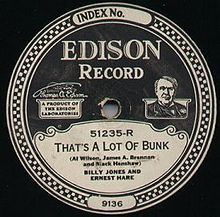- Edison Disc Record
-
The Edison Disc, also known as a Diamond Disc record, was a type of audio disc record marketed by Edison Records from 1912 to 1929.
Edison had previously concentrated on producing phonograph cylinders but decided to get into the disc market due to the increasing market share of disc sound recordings, especially the discs of companies such as Victor Talking Machine Company (what would later be called "78 records"). Victor and most other disc record companies used side to side or lateral motion of the stylus in the record groove, whereas in the Edison system the movement was up and down or vertical (also known as "hill-and-dale" motion), as in a cylinder record. An Edison Disc Phonograph is distinguished by the diaphragm of the reproducer being located parallel to the disc surface. The Victor (or similar) diaphragm is located at a right angle to the surface of the disc.
The grooves on an Edison Disc are smooth on the sides and have a variable depth. Standard lateral discs will have a more constant depth, but the sides of the groove are scalloped. As the Edison groove pitch (or "TPI", i.e. "threads per inch") was 150, a much finer grooving than that on lateral discs, Edison's 10-inch discs played considerably longer than Victor's or Columbia's -- up to nearly five minutes per side. The Edison Disc is also ¼-inch thick (supposedly to prevent warping), and was filled with wood flour, and later, china clay.[1]
Victor's system could not play Edison Discs as the needles used would cut through the recorded sound, and the Edison system could not play Victor or other lateral discs unless one used special equipment, like the Kent adapter. There is an example of a device to play Edison discs on a Victor machine.[2] The Brunswick Ultona was the only machine besides the Diamond Disc player that could play Diamond Discs, but Edison made an attempt at curbing this (a phonograph/gramophone that could play Edison, Victor/lateral 78s, and Pathé discs) by stating "This Re-Creation should not be played on any instrument except the Edison Diamond Disc Phonograph and with the Edison Diamond Disc Reproducer, and we decline responsibility for any damage that may occur to it if this warning is ignored."[3]
 Edison Records "Diamond Disc" label, early 1920s, featuring The Happiness Boys, Billy Jones and Ernest Hare
Edison Records "Diamond Disc" label, early 1920s, featuring The Happiness Boys, Billy Jones and Ernest Hare
The Edison records had their greatest commercial success in the mid 1910s to early 1920s, with sales peaking in 1920.[4] Diamond Discs arguably had better audio fidelity, but were more expensive than and incompatible with other brands of records, and ultimately lost out in the marketplace. In 1926, an attempt at reviving interest in the Edison Disc was with a 450-TPI long-playing disc, still spinning at 80 rpm, with times of 24 minutes per 10-inch disc and 40 for a 12-inch disc, but problems occurred (notably with broken groove walls and overall low volume, often only 40% of that of the regular discs), and the disc failed. In August 1927, discs began to be electrically recorded, making Edison the last major label to adopt electrical recording (over two years after Victor, Columbia, and Brunswick had converted from acoustical recording). Sales continued to drop, however, and although Edison Discs were available from dealers until the company left the record business in late October 1929, the last vertically-cut direct masters were recorded in the early summer of that year. The U.S. phonograph and record industry itself reached a historic nadir during that year, as the onset of the Great Depression and the rise of radio depressed sales and sent numerous companies out of business.
References
- ^ Edison Diamond Disc information from Tim Gracyk
- ^ http://pat.kagi.us/main.php?g2_itemId=15243 Pat's Antiques Gallery - possibly experimental Edison Disc adapter for Victor machines
- ^ Brunswick Phonographs and Records
- ^ Edison Diamond Disc Manufacturing Processes (1920–29)
See also
Categories:- Audio storage
Wikimedia Foundation. 2010.


